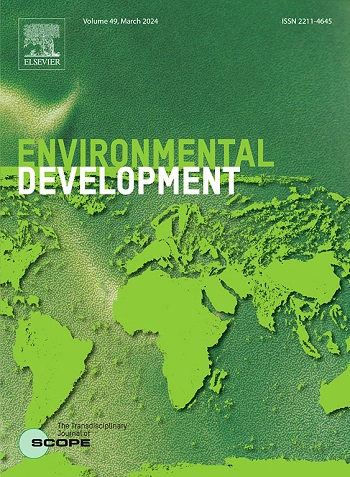当受教育机会比收入不平等更重要时:气候适应和减缓的结构方程建模分析
IF 5.3
2区 环境科学与生态学
Q2 ENVIRONMENTAL SCIENCES
引用次数: 0
摘要
本文旨在评估一个国家的教育水平对其采取的气候行动(适应和减缓)的影响,并衡量社会不平等、教育质量和受教育机会对此类行动的影响程度。为了实现这一目标,从全球数据库中存在的与教育、收入不平等、适应和缓解有关的18个指标中,对195个国家的样本应用了偏最小二乘结构方程建模(PLS-SEM)技术。主要结果是:a)教育水平对适应(.824)和减缓(.927)行动有积极影响;B)列入教育水平的二次项进一步强调了其在解释缓解行动方面的核心重要性(.460);c)同样,收入不平等的二次效应仅表现为减少碳排放的倾向(- 0.140);D)在绝对值上,获得教育的困难的间接影响(- .721)大于教育质量的间接影响(.302)。这些结果表明,除了需要保障全民教育外,各国还需要减少不平等现象。此外,发展中国家应优先采取行动,将儿童和年轻人纳入气候变化教育倡议,以便实现适应气候变化的间接影响,同时减少不平等现象有助于促进减少碳排放的努力。本文的政策含义是双重的。首先,本文强调,在适应和减缓气候变化方面,改善受教育机会比减少收入不平等更有影响力。其次,政策制定者应优先考虑扩大教育机会,特别是在脆弱地区,以增强气候适应能力和可持续实践。教育投资比单纯的收入再分配更能有效地推动长期气候行动。本文章由计算机程序翻译,如有差异,请以英文原文为准。
When access to education matters more than income inequality: a structural equation modelling analysis of climate adaptation and mitigation
This paper aims to assess the effects of the educational level of a country on the climate actions (adaptation and mitigation) that it adopts, and measure the extent to which social inequality, educational quality and access to schooling contribute to such actions. To achieve this aim, the Partial Least Squares Structural Equation Modeling (PLS-SEM) technique was applied to a sample of 195 countries from 18 indicators related to education, income inequality, adaptation and mitigation that exist in global databases. The main results are a) the level of education has a positive effect on adaptation (.824) and mitigation (.927) actions; b) inclusion of the quadratic term for educational level further underscores its central importance in explaining mitigation action (.460); c) Likewise, the quadratic effect of income inequality emerges only as a propensity to mitigate carbon emissions (−.140); d) in absolute values, the difficulty of accessing education has an indirect effect (−.721) that is greater than that of educational quality (.302). These results indicate that, in addition to the need to guarantee education for all, countries also need to reduce their inequalities. Furthermore, developing countries should prioritize actions to include children and young people in climate change education initiatives, so that the indirect effects of climate change adaptation are realized, while reducing inequality can help to foster carbon emissions mitigation efforts. The policy implications of this paper are twofold. First, the paper highlights that improving access to education is more impactful than reducing income inequality for climate adaptation and mitigation. Second, policymakers should prioritize expanding educational opportunities, particularly in vulnerable regions, to enhance climate resilience and sustainable practices. Investments in education can drive long-term climate action more effectively than income redistribution alone.
求助全文
通过发布文献求助,成功后即可免费获取论文全文。
去求助
来源期刊

Environmental Development
Social Sciences-Geography, Planning and Development
CiteScore
8.40
自引率
1.90%
发文量
62
审稿时长
74 days
期刊介绍:
Environmental Development provides a future oriented, pro-active, authoritative source of information and learning for researchers, postgraduate students, policymakers, and managers, and bridges the gap between fundamental research and the application in management and policy practices. It stimulates the exchange and coupling of traditional scientific knowledge on the environment, with the experiential knowledge among decision makers and other stakeholders and also connects natural sciences and social and behavioral sciences. Environmental Development includes and promotes scientific work from the non-western world, and also strengthens the collaboration between the developed and developing world. Further it links environmental research to broader issues of economic and social-cultural developments, and is intended to shorten the delays between research and publication, while ensuring thorough peer review. Environmental Development also creates a forum for transnational communication, discussion and global action.
Environmental Development is open to a broad range of disciplines and authors. The journal welcomes, in particular, contributions from a younger generation of researchers, and papers expanding the frontiers of environmental sciences, pointing at new directions and innovative answers.
All submissions to Environmental Development are reviewed using the general criteria of quality, originality, precision, importance of topic and insights, clarity of exposition, which are in keeping with the journal''s aims and scope.
 求助内容:
求助内容: 应助结果提醒方式:
应助结果提醒方式:


